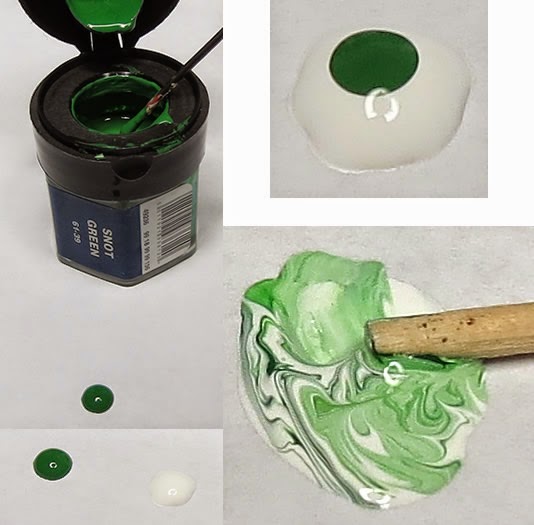 |
| Normally I use a slab of glass as a palette. For this tutorial, I'm using white paper for a clean background. |
Purchased colours are great for consistency. If you're painting a large army, it's best if you don't have to mix the colour for every model, because it won't be perfect every time. If you do need a mixed paint for a large uniform army, I'd suggest mixing a bunch up in an empty paint pot. (Which you can buy at hobby stores, re-use an old one, or use travel kit bottles from dollar stores.)
When you're doing the actual mixing, there's a couple ways I'll tackle it:
General Tips
The Easy Way
Just drip two paints together and mix them up. (I like to use toothpicks.) Use this when you're not overly concerned about how the colours turn out.
General Tips
- Lights get overpowered quick and Darks take over fast.
- If you're only changing a colour slightly, start with it and add a little of the second colour.
- Use a fluid retarder to prevent mixed paints from drying out before you're done.
- For army-amounts of paint, mix the paint in a pot.
The Easy Way
Just drip two paints together and mix them up. (I like to use toothpicks.) Use this when you're not overly concerned about how the colours turn out.
The Better Way
When you're after a specific mix of colour, here are some recommendations. I'm using White and Black to show the techniques, but these suggestions work for mixing two colours together too. Since this method is more efficient, you won't waste as much paint. Because it ends up thinner, you'll need more / better fluid retarder to prevent drying.
Tints (White) and Light Paints
It doesn't take much paint to overpower White and Light colours. My suggestion is to start with White / Light, then add in a little bit of the second colour at a time until you find the Tint / Colour you're after.
Shades (Black) and Dark Paints
Black and Dark colours quickly overpower other paints. Start with the paint you want to Darken, then mix in a little bit of Black / Dark at a time until you reach the Shade / Colour you're after.
Tones (Grey)
Basically, use the same rules as Tints and Shades.
Start with whichever is lightest, then mix in some of the darker one until you reach the Tone you're after.
 |
| source |
 I just want to point out that if you mix two Complementary colours (Those that are opposite each other on the colour wheel.) you end up with Grey. For example, Red and Green.
I just want to point out that if you mix two Complementary colours (Those that are opposite each other on the colour wheel.) you end up with Grey. For example, Red and Green.The lightness / darkness of the colours will determine how dark the grey is.
Mixing Other Colours
Because of the selection we have of paints, we typically won't be mixing Secondary colours like Orange, Green and Violet. Even Tertiary colours won't be mixed too often.
 But sometimes we might want to change or shift a colour a little bit. Like making an Orange look more Red. In cases like this, mix them the same.
But sometimes we might want to change or shift a colour a little bit. Like making an Orange look more Red. In cases like this, mix them the same.Using Fluid Retarder
I use a lot of Thinners in my work, one of the types is known as a Fluid Retarder, basically meaning that it causes paints to take longer to dry. The benefit over using water is that paint holds on to its colour better. I like to keep a cap of the stuff handy and actually always paint with a little of it on my brush to help paint flow.
Mixed paints need to last a while and if you add a little bit of a medium like this, they'll last longer.
(Blah, blah, blah, wet palettes... I've tried a few times and it seems wasteful to use enough paint to make a wet palette worthwhile.)






